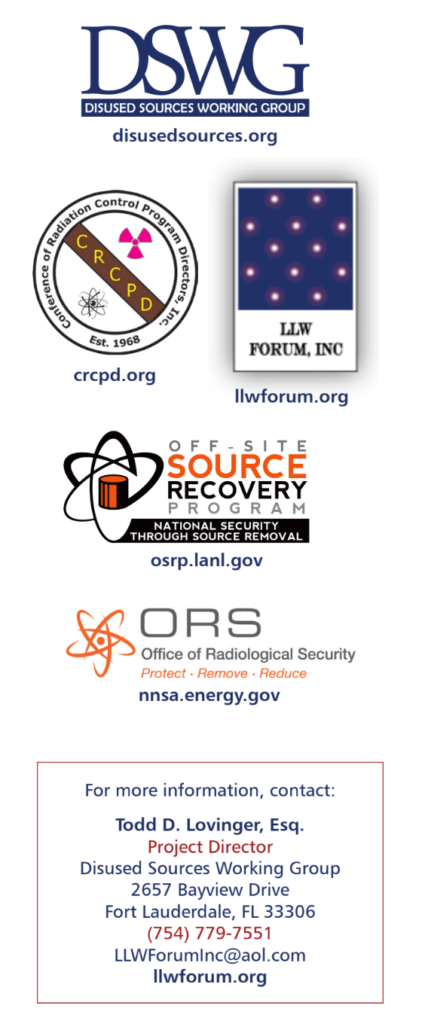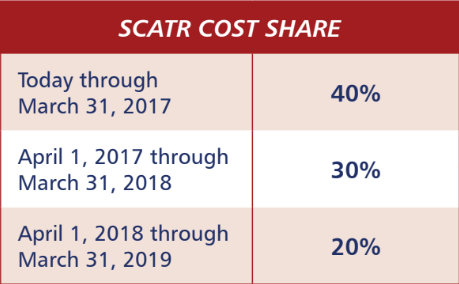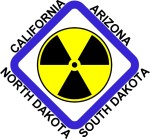POTENTIAL LIABILITIES OF STORING DISUSED SOURCES
The U.S. Government Accountability Office has estimated that an average of 250 sealed sources are lost, stolen or abandoned each year. While most are recovered, some are not.
When sources or devices are no longer in use they represent a potential liability. Disused sources must be properly secured to prevent loss, theft or other malevolent use. As the owner of disused sources or devices, you are legally and financially liable for the consequences should your radioactive material damage the environment or create a public health and safety impact.
In today’s national security environment, some disused sources pose a threat to the public as they could be used individually or in aggregate in a radiological dispersal device (RDD or dirty bomb) or a radiation exposure device (RED). Based on past emergency response training exercises, the U.S. Environmental Protection Agency (EPA) has estimated that an RDD incident in a major metropolitan area could result in 39 million cubic feet and 10 billion gallons of radioactively contaminated waste requiring disposal.1
[1] Boe, T., et. al., A Planning Tool for Estimating Waste Generation of a Radiological Incident and Subsequent Decontamination Efforts, Proceedings of the Waste Management 2013 Waste Management Conference In Phoenix, Arizona.
Printed on RECYCLED PAPER OR-1279 12/16

RADIOACTIVE
SEALED SOURCES
& DEVICES
_____________________
Proper Management
& Dispositioning of Disused
Sealed Sources
A disused source is any sealed source
of radioactive material that is not being
currently utilized and will never be utilized
again for its intended purpose.

PROPER MANAGEMENT AND DISPOSITIONING OF DISUSED SEALED SOURCES
________________________________________________________________
Disused sealed sources, devices and other unwanted radioactive materials should not be stored indefinitely. Rather they should be properly dispositioned in
a timely manner. Most sealed sources and devices can be managed by returning them to the manufacturer or through commercial waste brokers or disposal facilities. The following resources are available to assist licensees in properly managing and disposing of their disused radioactive sources and devices.
CONFERENCE OF RADIATION
CONTROL PROGRAM DIRECTORS
The Conference of Radiation Control
Program Directors (CRCPD) is a nonprofit
organization of individuals from
government agencies that regulate and
control the use of radioactive material
and radiation sources. They can assist
with finding, and in some cases funding,
an outlet for radioactive material. CRCPD
offers assistance in finding cost-effective,
legal disposition for radioactive material
through:
- Reuse by another licensee or device
manufacturer; - Reprocessing of the material;
- Commercial disposal; and
- Acceptance by state or federal
government.
The CRCPD maintains directories of
relevant commercial services including:
- Outlets for common radioactive
materials; - Packages, transportation and storage;
- Radioactive waste brokers and
decontamination services; - Radioactive site investigation and
decontamination services; and - Recyclers of high-activity sources.
SOURCE COLLECTION &
THREAT REDUCTION PROGRAM
The CRCPD administers the Source
Collection and Threat Reduction
(SCATR) program funded by the
U.S. Department of Energy (DOE) to
reduce the amount of unused radioactive
material stored by licensees. Working in
conjunction with state and local radiation
control programs, the SCATR program
provides matching funds for the recovery
and disposition of unwanted sealed
sources.
The SCATR program cost-share is being
reduced, so licensees are strongly
encouraged to take advantage of SCATR
at your earliest convenience in order to
maximize the benefit.

For additional information regarding
CRCPD and the SCATR program, contact
Russ Meyer at RMeyer@crcpd.org or visit
crcpd.org/RadioactiveMaterials.aspx.
OFF-SITE SOURCE
RECOVERY PROJECT
The Off-Site Source Recovery Project
(OSRP) is a U.S. Government activity
sponsored by the National Nuclear
Security Administration (NNSA). This
program has the mission to remove
excess, unwanted, abandoned or orphan
radioactive sealed sources that pose
a potential risk to health, safety and
national security.
Initially focused on transuranic sealed
sources, the OSRP mission expanded to
also include high activity beta/gamma
emitting sources that are a security
concern. Sources must be registered
with the OSRP at http://osrp.lanl.gov/
PickUpSources.aspx in order to be
considered for collection.
For additional information on the OSRP,
please go to www.osrp.lanl.gov.

____________________________________________________________________________________________________
